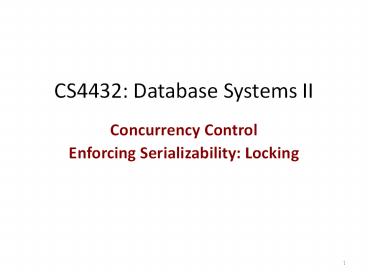CS4432: Database Systems II PowerPoint PPT Presentation
Title: CS4432: Database Systems II
1
CS4432 Database Systems II
- Concurrency Control
- Enforcing Serializability Locking
2
Enforcing Serializable Schedules
- DBMSs use a Scheduler that schedules the
actions of transactions - Transactions send their requests (R or W) to
Scheduler - The scheduler prevents the formation of cycles
- It grants permission to R or W only if no cycle
will be formed
3
Locking Protocol
- Scheduler uses a locking protocol to enforce
serializability - Two New actions
- Lock (exclusive) li(A) ? Transaction Ti
locks item A - Unlock Ui(A) ? Transaction Ti
unlocks (releases) item A
lock table
4
Rule 1 Well-Formed Transactions
- Ti li(A) pi(A) ui(A) ...
Any action (R/W) must be after the lock (l) and
before the unlock (u)
Rule 1 is at the level of each transaction
independent of the others
5
Rule 2 Legal Scheduler
- S .. li(A) ... ui(A) ...
no lj(A)
No transaction Tj can lock item A that is already
locked by another transaction Ti (Transaction Tj
must wait until Ti releases its lock)
Rule 2 is at the level of the complete schedule
(Set of interleaving transactions)
6
Schedule F Lets Add Some Locking!
7
Still Something is Missing
Still by applying the locks.results is not
consistent !!!
8
Rule 3 Two Phase Locking (2PL)
- Ti . li(A) ... ui(A) ...
No locks
No unlocks
- A transaction never start unlocks until it takes
all its locks. - In other words Take all locks before the first
unlock
Rule 3 is for each transaction
9
2 Phase Locking Protocol
of locks held by a transaction
Collect locks
Release locks
Growing Phase
Shrinking Phase
10
Schedule F Does it follow 2PL ?
11
Example 2PL Schedule G
12
Example 2PL Schedule G
13
Scheduler Forced Schedule G to be Serializable
14
Theorem
- Any legal schedule S following the 2PL
- ? Is a Conflict Serializable schedule
Most DBMSs use two-phase locking (2PL) to enforce
concurrency
15
Improvement 1 Handling Deadlocks
- 2PL protocol does not prevent deadlocks
- Transactions waiting for each other indefinitely
16
Handling Deadlocks
- Detection
- Wait-for graph
- Prevention
- Resource ordering
- Timeout
- Wait-die
- Wound-wait
17
Deadlock Detection
- Build Wait-For graph
- Ti ? Tj means Ti is waiting for Tj
- Use lock table structures
- Built incrementally by the scheduler
- When cycle found, rollback victim
18
Deadlock Prevention Timeout
- If transaction waits more than L sec., roll it
back! - Pros Simple scheme
- Cons Hard to select L
Check the other techniques in Textbook for your
knowledge
19
Improvement 2 Avoiding Cascade Rollback
- 2PL protocol does not prevent dirty reads
To avoid this situation, we use Strict Two-Phase
Locking (S2PL)
Now T2 is based on deleted transaction
20
Strict 2PL (S2PL)
- A transaction releases its lock only at commit or
rollback time
Commit or rollback event
of locks held by a transaction
Collect locks
Release locks
Growing Phase
Shrinking Phase
21
S2PL Example
22
Summary of Concurrency Control
- How to manage multiple transactions at the same
time - ? and still ensure consistency
- Schedules (order of actions)
- Serial, Conflict Serializable, Legal
- Precedence Graphs for Conflict Serializable
- Locking Protocol
- 2PL , S2PL, Handling of deadlocks

